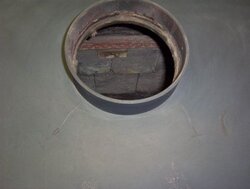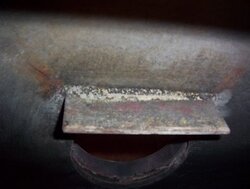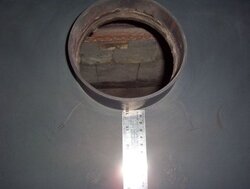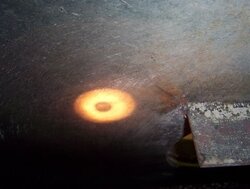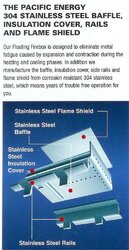Hello all,
I've been lurking for a couple of days now and I decided it was time to register and post question.
I experienced a rather freakish occurrence last Sunday. While loading up my 10 yo Osburn 2400 I noticed 2 cracks had developed in the cook top, emanating from the smoke pipe hole outwards, towards the center. One crack was 4" long, the other 2.5". They hadn't opened up very much, but they were visible. Of course, I became very concerned and immediately began a search to find another stove. As you can see in my sig, I am now a proud owner of a Summit, and boy, what a stove it is. More on that in a bit.
The cracks in the 2400 appear to have started exactly where the fire stop plate is welded to the bottom side of the cook top. I cannot confirm this, as I haven't yet taken the baffle apart to really have a good look. I will get at it this weekend. I always burned the stove as the book stated, allowing the secondary burn to start and throttle the stove back to anywhere between 25-50%.... depending on the temp outside. The stove was never over fired. I have always burned seasoned (I am always 2 years ahead with my wood) hardwood, consisting of maple, oak, ash and white and yellow birch. All of my wood is spilt and piled for 1 year on pallets and then moved into the wood house for the upcoming season. I built an 8X16 shed roof style wood house, which I can store about 6-6.5 cords of wood in, so there is never an issue with my wood not being seasoned.
What I would like to know is, has anyone ever had this happen to their Osburn before? If so, may I ask what was done with respect to warranty and such? I am currently corresponding with the warranty people at Osburn and they are very concerned about covering their own backside with my stove...meaning they are desperately trying to disprove my claim. I am fully aware of Osburn warranty; in that they do not cover the plate material the stove is constructed from. I am concerned though that this could be a defect which they may/should be wary over. Imagine a stove owner not as lucky as I to notice the cracks. I do not want to think of what would have happened it those cracks split and opened up and 3 am when my family was turned in.
So, I spent the afternoon on Sunday researching what was readily available in my locale. I opted for the PE Summit, primarily for the EPA rating and the heating capacity. A couple calls on Monday and I bought the stove that night.
Initially I was skeptical because of the size difference between the 2400 and the Summit. If the Osburn was the papa bear, the PE was certainly the baby!! But, the Osburn never did perform like the Summit….it kicks!
I've been lurking for a couple of days now and I decided it was time to register and post question.
I experienced a rather freakish occurrence last Sunday. While loading up my 10 yo Osburn 2400 I noticed 2 cracks had developed in the cook top, emanating from the smoke pipe hole outwards, towards the center. One crack was 4" long, the other 2.5". They hadn't opened up very much, but they were visible. Of course, I became very concerned and immediately began a search to find another stove. As you can see in my sig, I am now a proud owner of a Summit, and boy, what a stove it is. More on that in a bit.
The cracks in the 2400 appear to have started exactly where the fire stop plate is welded to the bottom side of the cook top. I cannot confirm this, as I haven't yet taken the baffle apart to really have a good look. I will get at it this weekend. I always burned the stove as the book stated, allowing the secondary burn to start and throttle the stove back to anywhere between 25-50%.... depending on the temp outside. The stove was never over fired. I have always burned seasoned (I am always 2 years ahead with my wood) hardwood, consisting of maple, oak, ash and white and yellow birch. All of my wood is spilt and piled for 1 year on pallets and then moved into the wood house for the upcoming season. I built an 8X16 shed roof style wood house, which I can store about 6-6.5 cords of wood in, so there is never an issue with my wood not being seasoned.
What I would like to know is, has anyone ever had this happen to their Osburn before? If so, may I ask what was done with respect to warranty and such? I am currently corresponding with the warranty people at Osburn and they are very concerned about covering their own backside with my stove...meaning they are desperately trying to disprove my claim. I am fully aware of Osburn warranty; in that they do not cover the plate material the stove is constructed from. I am concerned though that this could be a defect which they may/should be wary over. Imagine a stove owner not as lucky as I to notice the cracks. I do not want to think of what would have happened it those cracks split and opened up and 3 am when my family was turned in.
So, I spent the afternoon on Sunday researching what was readily available in my locale. I opted for the PE Summit, primarily for the EPA rating and the heating capacity. A couple calls on Monday and I bought the stove that night.
Initially I was skeptical because of the size difference between the 2400 and the Summit. If the Osburn was the papa bear, the PE was certainly the baby!! But, the Osburn never did perform like the Summit….it kicks!


